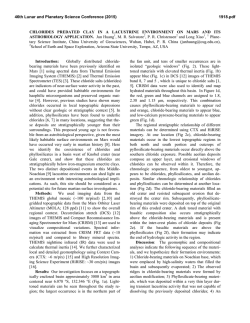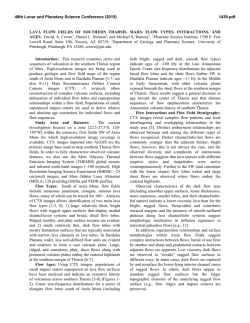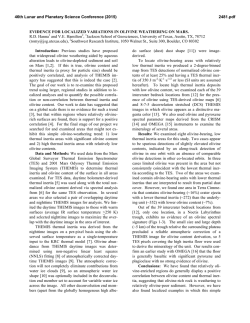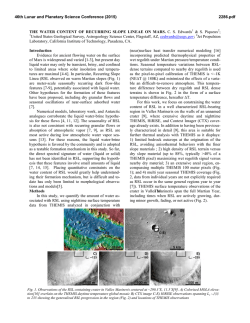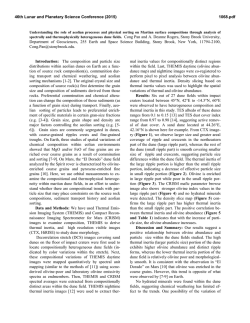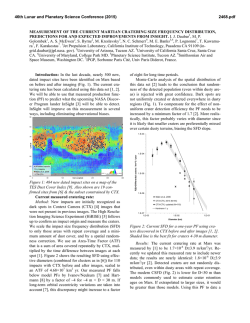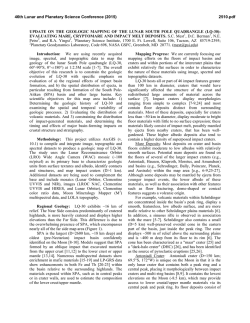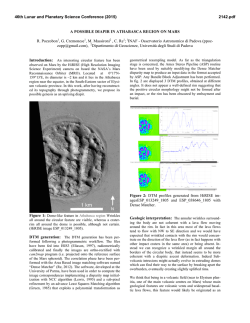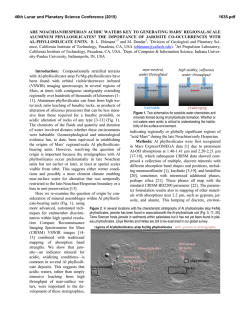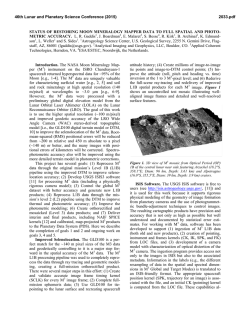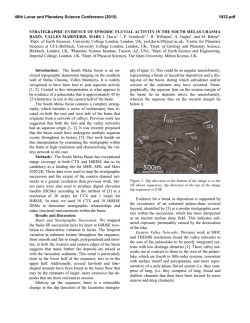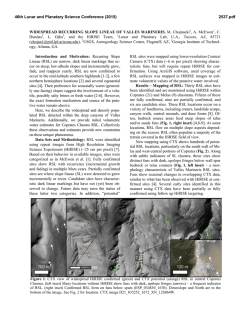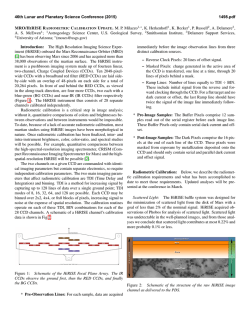
Thermophysical Characteristics of Lava Flows South of Arsia Mons
46th Lunar and Planetary Science Conference (2015) 2332.pdf THERMOPHYSICAL CHARACTERISTICS OF LAVA FLOWS SOUTH OF ARSIA MONS. C. M. Simurda1, M. S. Ramsey1, and D. A. Crown2, 1Department of Geology and Planetary Science, University of Pittsburgh, 4107 O'Hara Street SRCC, Room 200, Pittsburgh, PA, 15260; 2Planetary Science Institute, 1700 E. Fort Lowell Road, Suite 106, Tucson, AZ, 85719; [email protected]. Introduction: Significant mantling of the Martian surface by dust and sand influences the ability to investigate the underlying bedrock remotely, including in the Tharsis region [1]. Eolian deposits may be locally derived and preserve signatures of the underlying bedrock, however global homogenization hinders accurate interpretations [2-3]. Without in situ analysis, it is difficult to determine the source of the mantling deposits. Thus, it is vital to identify the degree of eolian mantling that obscures a study site to understand to what degree the bedrock spectral signature can be discerned and potentially determine its composition and alteration conditions. Using datasets from multiple instruments with different spatial and spectral resolutions allows interpretations of surface features previously considered to be too extensively mantled for spectral studies. Higher resolution imaging datasets such as HiRISE and CTX can be used to characterize surface formations, and lower resolution thermal remote sensing data can provide information about composition and particle size. Background: Arsia Mons is the southernmost of the Tharsis shield volcanoes and exhibits a summit caldera and two main aprons of flows originating from the NE and SW flanks [4-5]. The study area is located SW of Arsia Mons in Daedalia Planum (figure 1). These flows postdate shield formation and the overlapping relationships between adjacent flows can be identified. This region was selected for its extensive lava flow field, coverage by multiple datasets, and recent flow field mapping [6-7]. Previous studies suggest that this area is predominantly basaltic in composition and has a TES-derived albedo of roughly 0.22-0.24 and a dust cover index of 0.94-.97 [8-9]. Analysis of CTX and HiRISE images of this region suggest the presence of non-mantled outcrops of lava that are distinct from the mantling material [10]. Methods: A series of datasets were analyzed to characterize the thermophysical properties of the study area as well as the diversity of lava flows and tectonic features. These datasets include CTX and HiRISE images for context, the TES dust cover index, THEMIS day and night IR images, and TI derived from THEMIS night data [12-13]. CTX and HiRISE images were used to identify individual flows and determine local flow superposition relationships (figure 2). Fig. 2. CTX images from a subsection of the study site in the Daedlia Planum region with outlines of the lava flows (each color, except for blue, represents a different flow edge) and impact craters (blue). This is a subset of figure 3 to show the detailed mapping. Fig. 1. THEMIS Day IR Global Mosaic of the study site with MOLA DEM inset of the Tharsis and Daedlia Planum region [11]. The yellow box is the location for figures 2 and 3 centered at 234°E and 25.5°S. Specific limitations were placed on the THEMIS IR database search to ensure the best quality data would be selected. The following criteria were used: (1) acquired within the last 600 sols from August 2014, (2) contained all bands 1-10, (3) collected between the 46th Lunar and Planetary Science Conference (2015) local hours of 2:00-6:00 for night and 15:00-18:00 for day, and (4) surface temperature of 225-350 K for day acquisitions. Thermal inertia (TI) derived from THEMIS IR night data were compared with THEMIS IR day data to determine the thermophysical response of the identified flows to a diurnal cycle (figure 3). Thermal inertia (TI) characterizes the resistance of a surface to changes in temperature and is an accurate remote sensing method to determine the percentage of blocks, degree of mantling, and particle size. Additionally, in order to assign compositional constraints to the flow material, different channels from THEMIS IR images were compared (6-4-2, 8-75, and 9-6-4). Fig. 3. Comparison of THEMIS IR day brightness images (A) with thermal inertia derived from THEMIS IR night images (B). Results and Discussion: Although only a portion of the total study area has been analyzed, our preliminary results comparing thermal inertia and THEMIS IR day images show significant differences between neighboring lava flows. Because these flows all originate from Arsia Mons and are in such close proximity, this level of TI variability in the same flow field is unusual for Mars. Some flows display a significantly higher thermal inertia compared to adjacent flows, a behavior that is also seen in other flows in the Daedlia Planum region [14-15]. This thermal inertia relationship is indicative of a surface that is blockier, less mantled, and/or higher density. It could suggest the presence of a compositional and/or grain size difference between these flows. Alternatively, it may be caused by age or flow emplacement differences. Analysis of THEMIS DCS images does not suggest that the variations in 2332.pdf thermophysical response are the result of compositional differences, however. Distinct changes in composition are seen in the study area, but they do not correlate with flow boundaries. Additionally, age estimates of these adjacent flows using crater counting do not suggest that these differences are the result of consistent age differences [7]. Therefore, neither compositional nor age differences appear to explain these TI characteristics. Furthermore, occasionally very thin channels have been identified within major flows that have similar thermophysical characteristics to adjacent flows. In some cases these channels may be resurfaced with younger flow material that is also emplaced around a given flow. Further investigation is necessary to determine if these variations in thermophysical properties are the result of cyclical changes in flow emplacement or represents a continuous trend. Summary: The preliminary results of this study limit the possible explanations of these observations. Continuing to analyze the flows in Daedlia Planum by mapping these different day-night behaviors and comparing them with compositional or mantle thickness variations will help to identify the diversity of flow types in this region. It is also crucial to determine if there is a relationship between mantling thickness and these trends. Applying this approach to an expanded region of Daedlia Planum will provide information on how these thermophysical characteristics change along the length of an entire flow field. Finally, additional examination of these flows is necessary to determine if there is an overall regional trend in which younger material displays a higher thermal inertia. This will ultimately constrain the emplacement process of these flows and provide critical insights on how these volcanic processes deviate from similar terrestrial flows. References: [1] Malin M.C. et al. (2001) JGR, 106, 429-23, 570. [2] Edgett K.S. et al. (1993) J. Arid Environ., 25, 271-297 [3] Johnson J.R. et al. (2002) JGR, 107, E6. [4] Crumpler L.S. et al. (1996) Geol. Soc. Spec. Publ., 110, 725-744. [5] Lang N.P. et al. (2009) J. Volc. And Geotherm. Res., 185, 103-115. [6] Crown D.A. et al. (2010) LPSC, XLI, abs. 2225. [7] Crown D.A. et al. (2014) AGU, Fall, abs. P41B-3906. [8] Ruff S.W. et al. (2002) JGR, 107, 5127. [9] Head J.W. et al., (1998) LPSC, XXIX, abs. 1322. [10] Crown D.A. et al. (2009) LPSC, XL, abs. 2252. [11] Hill J. et al. (2014) 8th Int. Con. Mars, abs. 1141. [12] Fergason R.L. et al. (2004) JGR, 111, E12004. [13]Christensen P.R. et al. (2001) JGR, 106, 823, 871. [14] Ramsey M.S. et al. (2010) LPSC, XLI, abs. 1111. [15] Ramsey M.S. et al. (2011) AGU, Fall, abs. P42C-06.
© Copyright 2025
